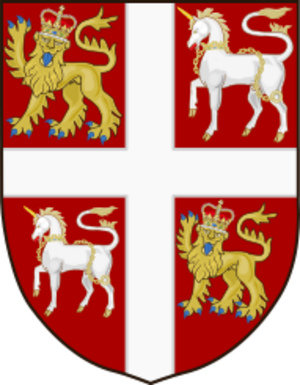Newfoundland Colony facts for kids
Quick facts for kids
Newfoundland Colony
|
|||||||||
|---|---|---|---|---|---|---|---|---|---|
| 1610–1907 | |||||||||
| Status | Colony of England (1610–1707) Colony of Great Britain (1707–1800) Colony of the United Kingdom (1801–1907) |
||||||||
| Common languages | English, Newfoundland French, Newfoundland Irish | ||||||||
| Religion | Church of England | ||||||||
| Government | Colony (1610–1854) Crown colony (1854–1907) |
||||||||
| Monarch | |||||||||
|
• 1610–1625
|
James I (first) | ||||||||
|
• 1901-1907
|
Edward VII (last) | ||||||||
| Governor | |||||||||
| History | |||||||||
|
• English Colonization of Newfoundland
|
1610 | ||||||||
|
• Dominion of Newfoundland established
|
1907 | ||||||||
| Currency | Newfoundland pound (until 1865) Newfoundland dollar (1865 onwards) |
||||||||
|
|||||||||
| Today part of | |||||||||
The Newfoundland Colony was a land ruled by England, and later by Britain. It was set up in 1610 on the island of Newfoundland. This island is off the Atlantic coast of what is now Canada. Today, it is part of the Canadian province of Newfoundland and Labrador.
Before 1610, English people had visited the island for many years. At first, they only stayed for part of the year, mostly for fishing. In 1824, Newfoundland became a Crown colony. This meant it was directly controlled by the British government. Later, in 1907, it became a Dominion. This gave it more control over its own affairs.
However, during the Great Depression, the economy of Newfoundland became very weak. So, in 1934, it gave up its self-rule. It became a Crown colony again, managed by officials from London. In 1949, the people of Newfoundland voted to join Canada. It became the Province of Newfoundland. In 2001, its name was officially changed to Newfoundland and Labrador.
Contents
History of the Colony
Long before Europeans arrived, Indigenous people lived in Newfoundland and Labrador. Groups like the Beothuk and Innu were the first inhabitants.
In the late 1400s, European explorers started visiting the area. Famous explorers like John Cabot and Jacques Cartier explored these coasts.
Around the early 1500s, fishing boats from England, Portugal, France, and Spain began visiting seasonally. Some of these fishing crews even started a small, unofficial settlement in a place called Placentia.
Sadly, the Beothuk people slowly disappeared. They caught new diseases from the European colonists. They had no natural protection against these illnesses. They also lost their land as English and French settlements grew.
Early English Settlements
Starting in 1610, the Kingdom of England began setting up official colonies in Newfoundland. These were led by special governors. England wanted to create strong footholds in North America.
John Guy was the governor of the first settlement at Cuper's Cove. Other early settlements included Bristol's Hope and Renews. The area of Avalon was organized as a province in 1623. Sir David Kirke became the first governor with power over all of Newfoundland in 1638.
Conflicts with France
During this time, France also had settlements in the region, especially in what is now Quebec. France had strong trade ties with many Indigenous peoples. These included the Mi'kmaq and other groups who spoke Algonquian languages.
England and France were often rivals in Europe. This rivalry also led to conflicts in North America. They fought for control of land and resources. This was especially true in Newfoundland. English settlements on the eastern coast were close to French claims in Southern Newfoundland. The French called their main settlement there Plaisance.
The Newfoundland colony faced a major attack during King William's War. In 1696, French and Mi'kmaq forces destroyed almost all English settlements on the island. However, over the next year, the English rebuilt and repopulated the colony. In 1713, the Treaty of Utrecht officially gave all of Newfoundland to the British Crown.
Newfoundland After the American Revolution
Newfoundland was far from the other British colonies to the south. It was also separate from the loyal colony of Nova Scotia. Because of this, Newfoundland did not join the American colonies in their rebellion in the 1770s.
After the American Revolutionary War ended in 1783, the United States became independent. Newfoundland Colony then became part of British North America. Some people who remained loyal to Britain during the war, called Loyalists, were resettled in Newfoundland. However, most Loyalists were given land in Nova Scotia and what is now Ontario.
Becoming a Crown Colony and Self-Government
Newfoundland officially became a Crown colony in 1825. Thomas John Cochrane, a naval officer, was appointed as its first governor. He oversaw the building of Government House. This building is now a National Historic Site of Canada. In 1832, the colony was given its own constitution. Cochrane became its first civil governor.
In 1854, the colony gained the power to govern itself. Philip Francis Little became the first Premier of Newfoundland from 1855 to 1858. Between 1864 and 1869, the colony chose not to join Canada.
In 1907, Newfoundland became the Dominion of Newfoundland. This meant it was a self-governing part of the British Empire. But due to economic problems in 1934, it gave up its self-government. It was then ruled by a royal commission. Finally, in 1949, Newfoundland and Labrador joined Canada. It became a Canadian province. In 2001, the province was officially renamed Newfoundland and Labrador.
See also
 In Spanish: Colonia de Terranova para niños
In Spanish: Colonia de Terranova para niños




